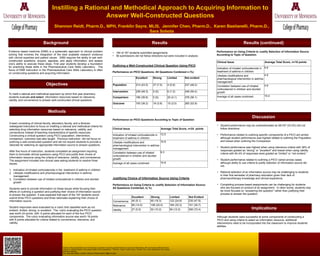
AACP Poster 2016_ 36 x 48_drug information in PDIs_FINAL
- 1. Authors of this presentation have the following to Background Objectives Results Discussion Outlining a Well-Constructed Clinical Question Using PICO Performance on PICO Questions: All Questions Combined n (%) Performance on PICO Questions According to Topic of Question Implications Although students were successful at some components of constructing a PICO and using criteria to select an information resource, additional interventions need to be incorporated into the classroom to improve students’ abilities. . Shannon Reidt, Pharm.D., MPH, Franklin Sayre, MLIS, Jennifer Chen, Pharm.D., Karen Bastianelli, Pharm.D., Sara Sobota Instilling a Rational and Methodical Approach to Acquiring Information to Answer Well-Constructed Questions Excellent Strong Limited Not evident Population 214 (43.5) 37 (7.5) 4 (0.8) 237 (48.2) Intervention 238 (48.3) 0 (0) 6 (1.2) 248 (50.4) Comparison 196 (39.8) 0 (0) 20 (4.1) 276 (56.1) Outcome 193 (39.2) 19 (3.9) 15 (3.0) 265 (53.9) Justifying Choice of Information Source Using Criteria Performance on Using Criteria to Justify Selection of Information Source: All Questions Combined, n( %) Evidence based medicine (EBM) is a systematic approach to clinical problem solving that involves the integration of the best available research evidence with clinical expertise and patient values. EBM requires the ability to ask well- constructed questions; acquire, appraise, and apply information; and assess one’s ability to execute these steps. First year students develop a foundation for practicing these skills in the Pharmaceutical Care Skills Laboratory. The focus of EBM instruction in the Pharmaceutical Care Skills Laboratory is often on constructing questions and acquiring information. Performance on Using Criteria to Justify Selection of Information Source According to Topic of Question Results (continued) Methods To instill a rational and methodical approach by which first year pharmacy students evaluate and select information resources based on relevance, validity, and convenience to answer well-constructed clinical questions. A team consisting of clinical faculty, laboratory faculty, and a librarian redesigned instruction to focus on instilling a rational and methodical criteria for selecting drug information resources based on relevance, validity, and convenience instead of teaching characteristics of specific resources. Constructing a clinical question using PICO (population, intervention, comparison, outcome) was also taught. Previous instruction did not focus on outlining a well-constructed question and did not require students to provide a rationale for selecting an appropriate information source to answer questions. After five hours of instruction, students completed an assignment requiring them to formulate clinical questions using PICO and justify their choice of information resource using the criteria of relevance, validity, and convenience. The assignment included one clinical case asking students to resolve three issues: 1. Indication of inhaled corticosteroids in the treatment of asthma in children 2. Lifestyle modifications and pharmacological intervention in asthma management 3. Correlation between use of inhaled corticosteroid in children and stunted growth Students were to provide information on these issues while focusing their efforts on outlining a question and justifying their choice of information source to answer the question. It was expected that each of the 167 students would submit three PICO questions and three rationales explaining their choice of information source. Student responses were evaluated by a rubric that classified work as not evident, limited, strong, or excellent. The rubric evaluating the PICO question was worth 24 points with 6 points allocated for each of the four PICO components. The rubric evaluating information source was worth 18 points with 6 points allocated for criteria related to convenience, relevance, and validity. Clinical Issue Average Total Score, n=24 points Indication of inhaled corticosteroids in treatment of asthma in children 12.5 Lifestyle modifications and pharmacological intervention in asthma management 10.9 Correlation between use of inhaled corticosteroid in children and stunted growth 9.3 Average of all cases combined 10.9 Excellent Strong Limited Not Evident Convenience 45 (9.1) 90 (18.3) 122 (24.8) 235 (47.8) Relevance 69 (14.0) 108 (22.0) 164 (33.3) 151 (30.7) Validity 27 (5.5) 50 (10.2) 59 (12.0) 356 (72.4) Clinical Issue Average Total Score, n=18 points Indication of inhaled corticosteroids in treatment of asthma in children 5.6 Lifestyle modifications and pharmacological intervention in asthma management 4.9 Correlation between use of inhaled corticosteroid in children and stunted growth 4.9 Average of all cases combined 15.4 • 164 of 167 students submitted assignments • 56 submissions did not follow directions but were included in analysis • Student performance may be underestimated as 56/167 (33.5%) did not follow directions. • Performance related to outlining specific components of a PICO are similar although student performance was highest related to outlining the Population and lowest when outlining the Comparison. • Student performance was highest when using relevance criteria with 36% of responses graded as “strong” or “excellent” and lowest when using validity criteria with 84.4% of responses were graded as “limited” or “not evident.” • Student performance related to outlining a PICO varied across cases although ability to use criteria to justify selection of information source did not. • Rational selection of an information source may be challenging to students in their first semester of pharmacy education given their lack of pharmacotherapy knowledge and clinical experience. • Completing process-based assignments can be challenging for students who are focused on product of an assignment. In other words, students may be more focused on “answering the question” rather than justifying their process to answer the question. Authors of this presentation have the following to disclose concerning possible financial or personal relationships with commercial entities that have a direct or indirect interest in the subject matter of this presentation.: Shannon Reidt, Franklin Sayre, Jennifer Chen, Karen Bastianelli, Sara Sobata: Nothing to disclose. For more information, contact: Shannon Reidt (reid0113@umn.edu)
